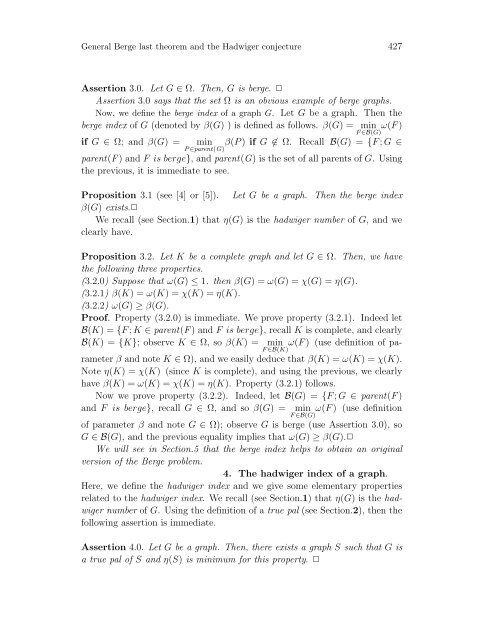With Concern the Difficult Part of the General Berge Last Theorem ...
With Concern the Difficult Part of the General Berge Last Theorem ...
With Concern the Difficult Part of the General Berge Last Theorem ...
Create successful ePaper yourself
Turn your PDF publications into a flip-book with our unique Google optimized e-Paper software.
<strong>General</strong> <strong>Berge</strong> last <strong>the</strong>orem and <strong>the</strong> Hadwiger conjecture 427<br />
Assertion 3.0. Let G ∈ Ω. Then, G is berge. ✷<br />
Assertion 3.0 says that <strong>the</strong> set Ω is an obvious example <strong>of</strong> berge graphs.<br />
Now, we define <strong>the</strong> berge index <strong>of</strong> a graph G. Let G be a graph. Then <strong>the</strong><br />
berge index <strong>of</strong> G (denoted by β(G) ) is defined as follows. β(G) = min ω(F )<br />
F ∈B(G)<br />
if G ∈ Ω; and β(G) =<br />
min<br />
P ∈parent(G)<br />
β(P ) if G ∉ Ω. Recall B(G) ={F ; G ∈<br />
parent(F ) and F is berge}, and parent(G) is <strong>the</strong> set <strong>of</strong> all parents <strong>of</strong> G. Using<br />
<strong>the</strong> previous, it is immediate to see.<br />
Proposition 3.1 (see [4] or [5]). Let G be a graph. Then <strong>the</strong> berge index<br />
β(G) exists.✷<br />
We recall (see Section.1) that η(G) is <strong>the</strong> hadwiger number <strong>of</strong> G, and we<br />
clearly have.<br />
Proposition 3.2. Let K be a complete graph and let G ∈ Ω. Then, we have<br />
<strong>the</strong> following three properties.<br />
(3.2.0) Suppose that ω(G) ≤ 1. <strong>the</strong>n β(G) =ω(G) =χ(G) =η(G).<br />
(3.2.1) β(K) =ω(K) =χ(K) =η(K).<br />
(3.2.2) ω(G) ≥ β(G).<br />
Pro<strong>of</strong>. Property (3.2.0) is immediate. We prove property (3.2.1). Indeed let<br />
B(K) ={F ; K ∈ parent(F ) and F is berge}, recall K is complete, and clearly<br />
B(K) ={K}; observe K ∈ Ω, so β(K) =<br />
min<br />
F ∈B(K)<br />
ω(F ) (use definition <strong>of</strong> parameter<br />
β and note K ∈ Ω), and we easily deduce that β(K) =ω(K) =χ(K).<br />
Note η(K) =χ(K) (since K is complete), and using <strong>the</strong> previous, we clearly<br />
have β(K) =ω(K) =χ(K) =η(K). Property (3.2.1) follows.<br />
Now we prove property (3.2.2). Indeed, let B(G) ={F ; G ∈ parent(F )<br />
and F is berge}, recall G ∈ Ω, and so β(G) =<br />
min<br />
F ∈B(G)<br />
ω(F ) (use definition<br />
<strong>of</strong> parameter β and note G ∈ Ω); observe G is berge (use Assertion 3.0), so<br />
G ∈B(G), and <strong>the</strong> previous equality implies that ω(G) ≥ β(G).✷<br />
We will see in Section.5 that <strong>the</strong> berge index helps to obtain an original<br />
version <strong>of</strong> <strong>the</strong> <strong>Berge</strong> problem.<br />
4. The hadwiger index <strong>of</strong> a graph.<br />
Here, we define <strong>the</strong> hadwiger index and we give some elementary properties<br />
related to <strong>the</strong> hadwiger index. We recall (see Section.1) that η(G) is <strong>the</strong> hadwiger<br />
number <strong>of</strong> G. Using <strong>the</strong> definition <strong>of</strong> a true pal (see Section.2), <strong>the</strong>n <strong>the</strong><br />
following assertion is immediate.<br />
Assertion 4.0. Let G be a graph. Then, <strong>the</strong>re exists a graph S such that G is<br />
a true pal <strong>of</strong> S and η(S) is minimum for this property. ✷
















